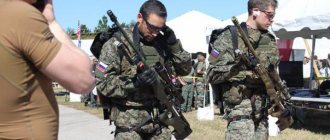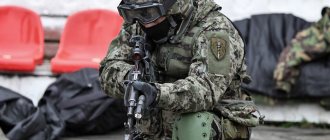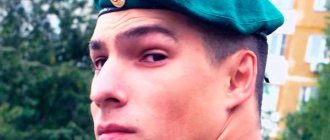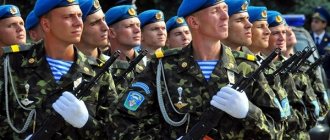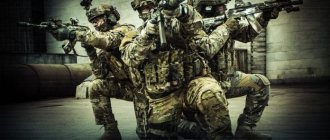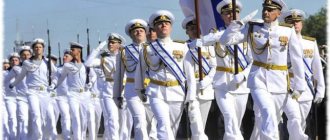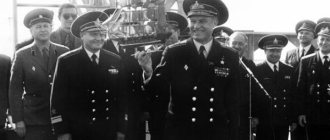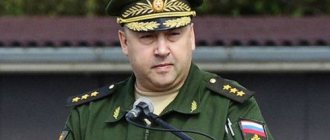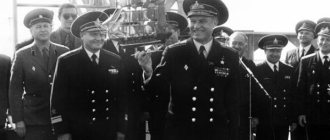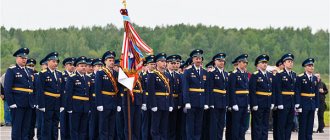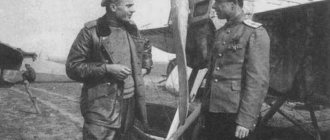Increasingly, in news reports from “hot spots” you can hear the word “special forces”, which means special forces units as part of certain security or law enforcement agencies. This indicates the increased role of special operations forces of the FSB and GRU units in resolving power conflicts.
To effectively achieve your goals, you need appropriate clothing, which, in addition to convenience, should protect the fighter from the harmful effects of the environment and enemy weapons.
Purpose of workwear
Nowadays, it is not uncommon to see reports on television channels, articles in the media, and Internet programs about various special forces units.
People ignorant of this issue can simply comment on the appearance of the fighters like this - they are all the same: camouflage, combat boots, berets, vests... But this is only at first glance.
All uniforms have historically established features. In addition to everyday quality, the military uniform of the GRU special forces, both in the old days and to this day, not only facilitates service, but also protects its owner.
The protective function allows a person, when performing official duties, to be protected from the effects of negative natural factors. Tactical clothing for GRU special forces also helps minimize accidents and the risk of unpredictable situations.
Types of clothing, styles
As a rule, the entire variety of uniforms of law enforcement agencies is focused on its classification according to seasonality:
- summer;
- winter
You can also notice the division of the form according to its direct application:
- A type of clothing for field activities. Used in combat. As a rule, the field uniform of the GRU special forces is accompanied by its use in the most difficult moments of service, therefore, special requirements are placed on it.
- The front door is ideal for presenting military and state awards, as well as special honors and performing an honor guard. You can't do without it on special days and weekends.
- Casual uniform. Applies in all other cases.
The ceremonial and demobilization uniform of the GRU special forces looks like in this photo:
Thanks to the high-quality uniform, the fighter is comfortable and comfortable even during unexpected combat missions.
For men
The variety of shapes and colors of clothing used by GRU units is mostly inherited from the USSR period. The main ones can be listed:
- "Amoeba". The most durable example of camouflage, the history of which goes back to 1935. At one time it was the basis of the developments of Soviet designers of military uniforms. It has currently been finalized and various variations are available.
- “Deciduous Forest” is an ideal military camouflage fabric. The uniform underwent a “baptism of fire” and served the soldiers of the Great Patriotic War of 1942 well.
- “Silver Leaf” (“Sunny Bunnies” or “Birch Tree”). Sketches of this sample were created back in the 50s.
- VSR-93, or folk “Vertical” (based on the vertical stripes on the uniform). The shape of the field character allows you to effectively merge with the surrounding background.
- VSR-98 "Flora". In wider military circles it is known as the “Watermelon” camouflage because of the stripes. This option is basic for special forces. In addition to its specific color, it has excellent camouflage characteristics, suitable for the central part of Russia.
- “Digital flora” or “Russian digital”. These are innovative developments of a new summer and winter uniform for special forces soldiers of the GRU, the Ministry of Internal Affairs and the FSB, which was developed by V. Yudashkin (Russian fashion designer).
Are you interested in knowing what the requirements are for firefighter clothing? There are also certain rules and requirements for it. Find out what materials safety split-leaf gaiters for welders are made from in this material.
What features does a black special forces uniform have and what requirements it must meet, read in this publication.
For women
Military special uniforms for women are created based on the male version, taken as a basis. At the same time, all the basic principles of reliability, comfort and resistance to any weather conditions are preserved.
The women's version of GRU special forces clothing is stand-up and has a special sizing chart intended exclusively for women. The jacket-shirt has a large number of necessary pockets. The pockets are presented with a straight version with Velcro.
Convenience is achieved by the fact that in the summer you can always roll up your sleeves. On the back of the pants there are reflective meshes that allow you to move without fear of getting dirt and perform a ventilation function.
What the GRU special forces uniform looks like for men and women, look at the photo:
In order for the item to retain its presentability and last as long as possible, you will need to follow the recommendations for washing it (look at the label).
The appearance of the beret in the army
During World War II, such hats became even more popular, especially among the Allied troops. US Special Forces soldiers noted the following conveniences of these hats:
- First of all, they hid the hair well;
- Dark colors were not visible in the dark;
- The berets were warm enough;
- He could wear a helmet or helmet.
Accordingly, some types and branches of the British and US troops adopted a headdress as one of the main elements of uniform. In the Soviet army, this element of clothing began to appear in the early sixties, as the main attribute of the landing force and special forces. Since then, the rules and wearing of such hats have remained virtually unchanged.
Vietnam experience
In Vietnam, Americans first wore Kevlar body armor. Movies about these tragic sixties, both documentaries and fiction, indicate that ordinary GIs wore dirty green cotton uniforms and metal helmets, sometimes covered with fabric or mesh covers so as not to glare in the sun. American special forces equipment was more complex and advanced. The uniform had spotted camouflage colors, body armor protected against fire damage, and the Green Berets had individual communications equipment (ISS), which helped to better coordinate the actions of units.
The first mentions of army headdress
The very first army berets appeared at the turn of the 17th and 18th centuries in England and Scotland. Then the warriors wear special hats that look like a beret. However, the mass distribution of such a headdress began only during the First World War. The first to wear them were soldiers of tank and mechanized units of the French army.
Next, the baton for the introduction of such an element of clothing was taken by Great Britain. With the advent of tanks, the question arose of what a tank driver should wear, because the helmet was very uncomfortable, and the cap was too bulky. Therefore, it was decided to introduce the black beret. The color was chosen on the basis that tankers are constantly working and are near equipment, and black soot and oil are not visible.
Concentrated Experience
One might assume that the very first item on the list of things needed in battle is weapons. This is, of course, true, but machine guns, machine guns, pistols, grenade launchers, flamethrowers and other deadly things are allocated to a completely separate category, and do not belong to equipment.
But uniforms, shoes, hats, backpacks, body armor, flasks and much more can be designated by this word. An ordinary ordinary soldier should be dressed comfortably, in accordance with the time of year and the climatic zone in which the service takes place. But there are also special troops. We will talk about them.
Of course, special elite units of any army are entitled to equipment appropriate to the complexity of the tasks they perform. Special forces equipment is the embodied concentrated military experience of mankind, accumulated over many centuries in conjunction with the latest technological achievements.
5.Tactical backpack
In addition to all of the above, each fighter carries a bunch of useful belongings: additional ammunition, food, water, maps, GPS, spare batteries for electronics, etc. Before using it, all this must be brought to the battlefield.
Every special forces soldier takes a tactical backpack on a long trip, where he puts all this necessary junk. These backpacks are made from the same nylon fabric as the body armor case. And they are equipped with the same MOLLE straps - what if there is not enough space inside? But why suddenly? It's never enough.
(Photo: Vitaly Kuzmin)
Therefore, a special forces soldier is often not visible under the load of his backpack with equipment. It is only given out by stripes with your favorite cat. Where would we be without them?
Structure and composition of the GRU Spetsnaz
According to available information, the GRU special forces currently include the following units:
- The 2nd separate special forces brigade is part of the Western Military District.
- The 3rd Guards Separate Brigade of the GRU (Central Military District) was created in 1966 in Tolyatti. However, there is information about its disbandment.
- 10th mountain separate brigade of the GRU of the North Caucasus Military District. It was formed in 2003 in the village of Molpino, Krasnodar Territory.
- 14th separate GRU brigade. Part of the Far Eastern District, it was formed in 1966. The soldiers of this unit took an active part in the fighting in Afghanistan. The 14th Brigade went through both Chechen campaigns.
- The 16th Special Forces Brigade is part of the Western Military District. Formed in 1963. She participated in both Chechen campaigns, in peacekeeping operations, and guarded particularly important facilities on the territory of Tajikistan in the early 90s.
- 22nd Guards Separate Special Purpose Brigade. It is part of the Southern Military District. It was formed in 1976 in Kazakhstan. She took an active part in the Afghan War. It is the first military unit to receive the rank of guards after the end of World War II.
- 24th separate GRU brigade. It is part of the Central Military District. The brigade took part in the Afghan War and in combat operations in the North Caucasus.
- 346th separate special forces brigade. Southern Military District, Prokhladny city. Kabardino-Balkaria.
- The 25th separate special forces regiment is part of the Southern Military District.
Also subordinate to the GRU there are four maritime reconnaissance points: in the Pacific, Black, Baltic and Northern fleets.
The total number of GRU special forces units is not known exactly. Various figures are cited: from six to fifteen thousand people.
Classification of special purpose units
Existing special forces units in Russia belong to different departments. The Russian Armed Forces have the following special forces units:
- Ground Forces (ground forces) - DShB brigades and DShP regiment;
- GU - 25th regiment and brigade;
- MO – center of Senezh;
- GRU - PDSS detachments of reconnaissance points Parusnoye (Baltic Fleet), Tuapse (Black Sea Fleet), Zverosovkhoz (Northern Fleet) and Fr. Russky/Dzhigit Bay (Pacific Fleet);
- Airborne Forces - 45th Guards Brigade (Kubinka);
- Navy - detachments of the Caspian Flotilla, Black Sea, Baltic, Pacific and Northern Fleet.
The Russian special services also have special forces units:
- FSB - operational support departments, regional departments and services, departments A (Alpha), B (Vympel) and C;
- Border Service of the FSB - regional services and departments, DShM of border detachments, special intelligence groups OGSpR;
- SVR – Zaslon detachment;
- Ministry of Internal Affairs - Thunder squad;
- National Guard troops - instead of internal troops, detachments were created: Wolverine (Krasnoyarsk-26), Rus (Simferopol), Skif (Grozny), Peresvet (Moscow), Svyatogor (Stavropol), Bulat (Ufa), Ratnik (Arkhangelsk), Kuzbass (Kemerovo) , Bars (Kazan), Mercury (Smolensk), Mechel (Chelyabinsk), Typhoon (Khabarovsk), Ermak (Novosibirsk), Edelweiss (Minvody), Vyatich (Armavir), Ural (Nizhny Tagil), Rosich (Novocherkassk), 604 TsSN;
- Rosgvardia - combat units of SOBR and OMON;
- FSIN - republican departments Saturn (Moscow), Rossy (Sverdlovsk), Typhoon (Lenoblast), Iceberg (Murmansk), Guardian (Chuvashia), Akula (Krasnodar), Yastreb (Mari El), Vulcan (Kabardino-Balkaria);
- Ministry of Emergency Situations – special risk center Leader;
- FSUE Communications-Security – Mars department.
Some of the above special purpose units are military, that is, by default they are staffed by military personnel. The other is departmental, that is, it employs employees who are assigned special ranks, not military ones. The two largest ministries of the Russian Federation include both:
- Ministry of Internal Affairs - the special forces of the National Guard are staffed by military personnel, riot police and special forces are not military formations;
- FSB - special forces of the border troops and departments A, B and C, respectively.
Special forces units carry out combat missions in populated areas and forests, under water and in the air, so field uniforms, ammunition and weapons are very different. A presidential decree in 2005 prohibited the use of insignia and military uniforms in the security units of the FSB, FSKN, Ministry of Internal Affairs, FSIN, PPS and other departments formed not from military personnel.
Medical pouch
Do you know what special forces are taught almost as intensely as how to shoot? Providing first aid on the battlefield. Each squad member must be able to save the life of his comrade: stop the bleeding, apply a bandage, prepare the wounded for evacuation, and most importantly, not kill him in the process of these manipulations.
So a medical pouch (indicated by a cross) is an important component of the equipment of any special forces soldier. At a minimum, it contains a hemostatic tourniquet (the so-called tourniquet - now the most common system in the world is called CAT). Usually they carry at least two or three of them: one in a pocket on the hand, another in a pocket on the leg, and the third in a pouch. The second number in the first aid kit are hemostatic agents: Cellox, Hemostop and the like. They allow the blood to clot faster so that the wounded person has a better chance of not dying from blood loss. Bandages used to seal wounds are often impregnated with such agents. Well, and painkillers, which temporarily block the pain shock caused by the injury.
(Photo: Vitaly Kuzmin)
All this - and much more - is packed into a special pouch and hung on the equipment so that it can be quickly used in a critical situation.
However, one of the unshakable rules of providing assistance on the battlefield is: Use the first aid kit of a wounded soldier first. After all, yours may be useful to someone else.
Uniform care
The most important element of valiant military bearing is impeccable appearance. It's no secret that military uniforms require careful care. In regular and especially solemn situations, wearing dirty, wrinkled, unkempt clothes is strictly prohibited. Russian special forces uniforms must look impeccable.
It is recommended to wash and iron field and casual uniforms according to the information indicated on the tags. It is better to entrust the care of your dress uniform to dry cleaning.
And finally! The Russian army is on the verge of large-scale modernization, one of the projects of which is the introduction of “Ratnik” combat equipment. The new Russian special forces uniform is a complex of everything a soldier needs on the battlefield: clothing, weapons, ammunition, medicine, as well as guidance, tracking, and communications systems.
The main goal of modernization in general and the warrior in particular is to turn an ordinary fighter into a multi-functional super-soldier!
Increasingly, in news reports from “hot spots” you can hear the word “special forces”, which means special forces units as part of certain security or law enforcement agencies. This indicates the increased role of special operations forces of the FSB and GRU units in resolving power conflicts.
To effectively achieve your goals, you need appropriate clothing, which, in addition to convenience, should protect the fighter from the harmful effects of the environment and enemy weapons.
Special forces "fashion"
It is difficult for an uninitiated TV viewer to even guess how complex the special forces equipment is. The photo of soldiers of special forces units amazes with the multitude of mounted pouches, built-in technical means and devices. Basically, all this is fixed on the so-called “unloading”, which frees up the hands and reduces the weight of the backpack, and at the same time protects the fighter. According to the latest “fashion”, it should be modular, that is, consist of several functional elements.
What will the new special forces equipment be like? Maybe Russian inventors and designers will be able to surprise the whole world with their achievements in this area?
Types of special forces camouflage
The special forces uniform is made from special fabrics that meet the requirements of safety, ergonomics and protection. FSB special forces fighters often need to disguise themselves and become invisible to the enemy. For such cases, clothing with appropriate patterns is provided. Each country has its own types of camouflage.
The most common camouflage fabrics for military clothing created in the United States include:
- MARPAT.
The name of the fabric comes from the abbreviation of the phrase Marine Pattern. It is used, among other things, for sewing uniforms of the American Marine Corps special forces. It combines shades of green, brown and black. Refers to advanced “digital” coloring. It has been experimentally established that this type of pattern “breaks” the symmetry of the human silhouette more effectively than the usual one, since there are no obvious junctions of contrasting colors, and the pattern is divided into rectangular parts. Produced in 3 variations: basic; - urban;
- desert (no green color).
The most popular camouflage comes from the USA. The name “NATO” is still attached to it, although the states included in this military bloc have their own individual uniform colors. It was created in the 80s of the last century specifically for the army and special forces. Black, brown, dark and light green colors serve for camouflage in the forest. The disadvantages of this material include the black tint that the fabric acquires after getting wet. A fighter wearing such clothing can easily be detected by the enemy. Available in 4 colors:
- base;
Short for "army combat uniform pattern". This uniform is intended for the US ground forces and special forces that are part of them. The term covers not only the color, but also the cut of clothing. The advantage of ACU PAT over Woodland is that the former does not turn black when wet as a result of a lighter color range, including medium, light and dark shades of gray.
The colors of camouflage clothing used by the special forces of Russia and Ukraine for the special forces of the GRU, the Ministry of Internal Affairs or the FSB are largely inherited from the USSR. We list the main types of drawings:
- "Amoeba".
One of the oldest camouflages, developed by Soviet specialists in 1935. Has various versions. - “Deciduous Forest”
, camouflage military fabric, which was created for the soldiers of the Great Patriotic War in 1942. - “Silver leaf”
, also known as “sunny bunnies”, also known as “birch tree”. A deforming pattern of this type was developed in the 50s of the last century in the USSR. - VSR-93
, popularly called “vertical” due to the vertical stripes. A field form that effectively breaks up the silhouette against a plant background. - VSR-98 "Flora".
Nicknamed “watermelon” camouflage because of its characteristic stripes. Basic camouflage for special forces of the Russian Armed Forces. Along with the specific color, it has excellent camouflage characteristics in relation to the central part of Russia. - “Digital flora”
, also known as “Russian digital”. New summer and winter uniforms for fighters of special units of the GRU, Ministry of Internal Affairs and FSB, the design and colors of which were developed by Russian fashion designer V. Yudashkin.
Modeling of central heating system “A” - “Alpha”
Modeling of control “A” of the TsSN FSB of Russia
The history of this unit began in the Soviet Union, within the KGB. The generally accepted name for this unit is “Alpha”.
Unit employees carry out complex counter-terrorism operations, relying on tactics and special means.
From the moment the unit was organized to the present day, Alpha fighters have carried out special operations in various parts of the world: Switzerland, Cuba, the USA, Afghanistan and so on.
Alpha fighters in Afghanistan
One of the first employees of department "A"
Speaking about the main weapons, it is worth noting that in the arsenal of Alpha fighters there are a large number of different types, which are not limited to one line of Kalashnikovs, but it is important to remember that the emphasis is on domestic weapons. II
Dress
II. Dress
When choosing “Alpha” as a modeling object, it is worth remembering that these are special forces operating throughout the world over a long period of time.
In counter-terrorist operations (CTO) in the Caucasus, the following camouflages were used: “Frog”, “Partisan”, “Izlom”, as well as some other camouflages of that period. Read about different camouflages in this article.
Having said about the “color” of clothing, it is important to remember about the correct cut; it would be wrong to purchase any clothing in the highest named color. Typically, the designated unit uses field uniform sets of the “Gorka” type (usually in classic colors) or “Beryozka” (clothing of a similar cut can also be in the “Partizan” color scheme, you can use a set of clothing that was previously in service in the VSR-Flora color scheme
When modeling the Alpha TsSN of the KTO period, you can use various “general army accessories.” More information about the Gorka kit can be found here.
II.II Modern period
Today, the fighters of TsSN "Alpha" wear a wide variety of equipment. Speaking of camouflage, it is worth highlighting: Black, Multicam, EMR Summer. Read about the Multicam camouflage in a separate article.
Speaking about the cut, it is worth noting that as equipment in black color, you can use a set of the “Gorka” type, for EMR Summer you should choose the “VKBO” set, the uniform in the “Multikam” color is selected individually based on the needs, this can be a special field set uniforms, and a set of tactical trousers and a tactical shirt.
III. Personal armor protection and unloading systems
We can say that “the helmets are of the type LShZ, Mask, Altyn. When it comes to body armor, preference should be given to Defender and Redoubt. It is worth choosing a cover for the helmet so that its color matches the rest of the camouflage. Most often in airsoft, “body armor” refers to the body armor cover itself, which is not as easy to change as a helmet cover, so you should choose a body armor vest of the required color.
Helmet of the “Altyn” type (protection class 2 allows the helmet to withstand a hit from a PM, but at the same time it carries from 3.5 to 4 kilograms)
Helmet LShZ-1+ (Is a domestic copy of FAST Helmet)
The choice of unloading system also depends on the period being modeled. For the first period, it will be relevant to use the SMERSH RPS; for the second period, you can use MOLLE type vest bases. Do not forget that in some situations Alpha fighters can use equipment adopted by the Russian Army; read the corresponding article about this equipment.
IV. Other accessories.
Do not forget that airsoft is still not a counter-terrorist operation. Safety glasses are a must for the kit; preference should be given to open-type glasses.
Previously designated helmets, even their replicas, are a very significant load; when taking a break from wearing them, it is recommended to use a headdress of a color similar to your main camouflage.
It is important to use tactical gloves, which should not only protect your hands, but also not violate your disguise. For night operations it is recommended to purchase a flashlight, the model of the flashlight depends on your preferences
For night operations, it is recommended to purchase a flashlight, the model of the flashlight depends on your preference.
Distribution in the USSR Armed Forces
In 1967, an updated uniform was adopted for the Airborne Forces. Famous Soviet artist A.B. Zhuk submitted a proposal for consideration by General V.F. Margelov to use crimson hats as an attribute of paratroopers, referring to the use of such hats in other countries of the world. The commander agreed and the beret was approved. For privates and sergeants, there was an emblem in the form of an asterisk, which was attached to the front center of the beret, and on the right was a blue flag, and for officers a cockade was provided.
A year later, a blue beret was adopted for paratroopers, since the leadership considered that it more symbolizes the color of the sky. As for the Marine Corps, the color black was approved for this type of troops. Black berets were also used by tank crews, but not as the main gear, but during maintenance and repair of equipment to protect their heads from dirt.
What is the Russian Guard?
The Russian Guard is an executive body. It was created in 2016 on the basis of the Russian internal troops.
The main specifics of the service do not require equipment or special weapons. The issue of changing clothes was raised simultaneously with the creation of the Russian Guard.
It included departments of police units and private security.
So army and police special forces perform different tasks, but at the same time closely interact with each other. The form satisfies the specifics of the activities of each department.
The Russian Guard has the right to license certain types of activities, they are related to security activities. Forceful actions will also be carried out, as the Russian Guard will monitor the readiness of troops in peacetime and wartime
. The powers of the body are quite extensive, since the Russian Guard can develop uniforms for training in professional institutions.
The authority may have access to the requested information of authorities, organizations and associations. It can stop the use of networks and communications. The Russian Guard has the right to organize an examination, but only in those activities that are assigned to it. Based on established documents, the body is the highest among the military, and it has the right to exercise two of the three branches of government.
Main functions:
- Work with the internal affairs bodies of the Russian Federation;
- Maintaining public order;
- Ensuring security and emergency conditions;
- Ensuring the legal regime;
- Fight against terrorism and extremism;
- Security of important government cargo;
- Supervision of compliance with legislation in the field of arms trafficking;
- Protection of private activities.
The military can check documents and make arrests. If an emergency occurs, employees have the right to prohibit the movement of pedestrians and use citizens' vehicles to travel to the scene of the situation. It is prohibited to use weapons against pregnant women and persons with disabilities.
The Russian Guard has the authority to control the actions of the National Guard. However, the authority's sphere of influence is broader. The body itself is legislative, but is endowed with the right to introduce new laws in areas that are under its control, namely:
- Activities of the National Guard;
- Prevention of administrative offenses;
- Security of cargo and strategically important objects;
- Protection of private property.
What does it contain?
- Internal troops of the Ministry of Internal Affairs;
- Special Forces Response Center;
- Rapid Response Squad;
- Mobile detachment;
- Aviation Special Purpose Center;
- Management body for organizing licensing and permitting work.
The subordinate organization is the National Guard.
Intelligence services of the post-war era
In the post-war years, attention to ammunition issues only increased. Since Stalin's times, a number of intelligence services have been created in the USSR, each of which had its own departments, independent of each other.
Such an organization of information support for the country's leadership, despite departmental disunity, is completely justified. You can compare information obtained from different sources and draw conclusions about their reliability. Today it is difficult to judge which department was the most effective, but there is no doubt that, along with the all-powerful State Security Committee, the Main Intelligence Directorate of the Ministry of Defense made a significant contribution to the defense of the Motherland on invisible fronts. Each of these services, modestly called competent, had special divisions. The requirements for their employees were not just high, they could be called unique. And, of course, the country supplied them with everything necessary to carry out especially important tasks. The equipment of the special forces of the Soviet intelligence services was created in secret institutions, and experienced saboteurs who had gone through more than one war served as consultants in them.
Protection: helmet and armor
And bullets are whistling, bullets,” was sung in one famous song, and for good reason. The work of a fighter involves risk to life, and this life must be protected as long as possible. After all, the completion of the mission at least depends on this.
Today, special armored vests and helmets provide protection to special forces all over the world.
The design of the Plate carrier is quite simple: these are two covers made of thick nylon fabric (cordura) connected by shoulder and side straps, into which specially shaped plates are inserted.
Each country is trying to come up with something different in terms of the type and composition of the plates, but the most widespread format in the world today is the American SAPI. Many commercial companies make body armor tailored to its size. This means that a fighter will always find the necessary protection for any required task. If you want pure armor, get it. If you want to attach a collar and groin protection to it, please do. If you want PALS (Pouch Attachment Ladder System, better known as MOLLE - MOdular Lightweight Load-carrying Equipment) straps on top for attaching additional pouches, nothing could be simpler.
(Photo: Vitaly Kuzmin)
By the way, the presence of the MOLLE system or its variations on the body armor cover is now almost mandatory.
With helmets the situation is even more complicated. Even the most enlightened user will get confused in their diversity. Some units use lightweight head protection to make parachuting more comfortable. For others, give a helmet of almost the fifth or sixth class of protection, capable of holding a machine gun bullet - after all, they have to storm a house in which bad guys have settled, not burdened with morality and not willing to surrender.
(Photo: Vitaly Kuzmin)
But on any helmet you will see a mount for additional equipment: NVD (night vision device), active headphones, IR markers (for identifying friend or foe) and other terribly secret and expensive equipment. Oh, and cat patches, yes.
Features of the special forces uniform of the Russian Army
Ordinary people who are not involved in military service have a strong opinion that military uniforms are of the highest quality and best wear resistance. And this is not without reason! After all, the main features of the special forces uniform are to ensure maximum comfort for the wearer.
Regardless of the climatic conditions in which a soldier finds himself, the special forces uniform must minimize the possible inconvenience of weather conditions, be it heat, cold, gusty wind or pouring rain. In addition, despite the external bulkiness, the suit should not constrain or impede movement, allowing you to quickly respond to any unforeseen situation.
Thus, the main principles that workwear must meet are practicality, convenience and functionality. In these matters, without a doubt, the main role is played by the fabric from which it is made.
A popular material among many workwear manufacturers is rip-stop (RIP-STOP), which is based on heavy-duty nylon threads woven crosswise, which guarantees the durability of the product. Suits made from this material are durable, frost-resistant, waterproof, windproof, not flammable from sparks and do not fade in the sun, and are also relatively lightweight.
Another purpose of special clothing is camouflage, allowing a soldier to blend into the surrounding area and remain unnoticed by the enemy. Camouflage clothing is divided into three categories:
- one-color (a striking example is winter white or one-color sand, called “sand”);
- camouflage (on the fabric there are two or more colors representing some kind of pattern);
- clothing using additional camouflage materials.
Flexible body armor: myth or reality?
Ultra-light, flexible and ultra-durable body armor is the dream of any fighter.
However, a flexible body armor must contain a liquid or plastic material inside, which must instantly harden with minimal mechanical impact. The material, in all likelihood, is equally easily exposed to other environmental influences (sun, water). “I believe that manufacturers of modern body armor do not use flexible or liquid material, since the issues of protecting it from external influences (sun, water, sweat, mechanical stress, temperature changes, etc.) have not yet been resolved. For example, if a fighter or employee simply fell on a stone, will the armor element harden? What must be the actuation force of this mechanism for the matter to harden? How to dissipate the energy of a bullet after hitting a body armor of this type; if this is not done, then the fighter may die from a concussion injury, despite the fact that there was no penetration? There are still more questions than answers in this area. Although we cannot exclude the fact that sooner or later they can be resolved,” argues Ivan Lobanov.
Perhaps science will soon step forward, but for now, anatomical hybrid ceramic-polyethylene armor panels that follow the contour of the human body are considered the most suitable.
https://youtube.com/watch?v=JlcUq-Qp8Hw
Types of special forces uniforms
The classification of uniforms of law enforcement agencies is universal, regardless of whether it is GRU special forces or the FSB. According to it, a military uniform is:
- summer;
- winter
In addition, there is a division of the form according to purpose:
- The field dress is worn during a military or emergency situation, during combat operations, natural disasters and the elimination of their consequences, during combat duty and exercises. The field clothing of a special forces soldier accompanies him in the most difficult moments of his service, so special requirements are placed on it.
- The front door is used during the presentation of the battle flag and the receipt of state awards, when performing a guard of honor, as well as on parade days and weekends. During the raising of the Naval flag on the ship and the launching of the ship, a dress uniform is also worn.
- Casual clothing is used in all remaining cases.
Glavrazvedupr
An Army intelligence officer may work abroad illegally, with or without diplomatic cover. In this case, he wears a good civilian suit, speaks the language of the country in which he lives, without an accent, and tries in everything to be like its ordinary citizen. Soviet intelligence officers were even forbidden to wear sunglasses, so as not to conform in any way to the cinematic image of the “red spy.” It’s another matter if such an officer performs a special mission during hostilities. The equipment of the GRU special forces was equipped differently depending on climatic conditions and the nature of the tasks. For example, in the tropics, an indispensable item of clothing was the so-called “net”, woven from a special rope. Mosquitoes, mosquitoes and other blood-sucking insects, even having pierced clothing with their stings, could not reach the skin with them, and the air gap contributed to better heat transfer. The shoes were also special, with a heel on the toe, in order to mislead possible pursuers (of course, not very experienced ones) regarding the direction of movement. The equipment of the GRU special forces included a special saboteur jacket, the tailoring of which took into account all ergonomic requirements based on the rich experience of army intelligence.
History of special forces
The roots of special forces are quite deep. The first formations in Rus' were endowed with the main goal: ensuring the security of the state. The problem of creating special detachments was raised by Russian commanders: General Pyotr Panin, Infantry General Alexander Suvorov, Field Marshal General Mikhail Kutuzov.
These units were called Jaeger regiments, their appearance dates back to 1874. These units became the founders of modern special forces.
The tactics of huntsmen in combat were used by Catherine II. The combat training of Jaeger detachments is similar to the principles of action of modern special forces: organizing agents and collecting the necessary information and force reconnaissance associated with striking, disabling combat complexes, warehouses, ships, control centers and many other tasks.
Dolman, short jacket with cords, tight trousers, dark green. Only the huntsmen's uniform included a green overcoat, which they wore folded over their backpack.
In 1917, the Bolsheviks established the People's Commissariat for Military and Naval Affairs, which was later entrusted with the leadership of all the armed forces of the Republic.
Then, in 1918, military intelligence and special purpose units (CHON) were created. CHON was subordinate to the Cheka and was intended for:
to fight the Basmachi and remnants of gangs; tasks of prompt suppression of conspiracies and rebellions; protection of political, economic and military facilities of national importance; participation in hostilities while in the front line.
ChON and units of the Red Army had the same organizational structure. The special forces units included infantry, cavalry, artillery and armored units, formed from the most trained soldiers.
The external and internal situation gradually stabilized and in the period 1924-1925, by decision of the Central Committee of the RCP (b), the ChON were disbanded.
During the war years, special forces with vast reconnaissance and sabotage experience were formed. However, after the end of the bloody war they were disbanded.
In the 50s, the need to form special units again arose. The main reason was the emergence of mobile nuclear weapons, which were adopted by some armies of NATO member countries.
Only specially trained soldiers could reconnaissance and destruction of new weapons that threaten the security of the country. They were entrusted with reconnaissance in the deep rear and carrying out sabotage operations aimed at eliminating dangerous weapons.
Operating procedure
The concept of using special forces tactics and strategy in the Soviet Union was originally proposed by military theorist Mikhail Svechnikov, who envisioned the development of unconventional warfare to overcome the shortcomings that conventional military forces faced in the field. Svechnikov was executed during the Great Purge in 1938, but the practical implementation of his ideas was started by Ilya Starinov, who was dubbed the “grandfather of special forces
" After the entry of the Soviet Union into World War II, the main forces intended to conduct reconnaissance and sabotage operations were formed under the leadership of the Second Directorate of the General Staff of the Soviet Armed Forces and were subordinate to front commanders.
The primary function of special forces troops in wartime was to penetrate/infiltrate behind enemy lines (either in uniform or in civilian clothing), usually well before the scheduled start of hostilities, and, once in place, commit acts of sabotage such as destroying vital communications . logistics centers, as well as the assassination of key government leaders and military personnel. GRU Spetsnaz training included: weapons handling, rapid rappelling, explosives training, marksmanship, counter-terrorism, aerial training, hand-to-hand combat, climbing (climbing rope technique), diving, underwater combat, emergency medical training, and demolition.
The difference between the uniform of the GRU special forces and other branches of the military
Special forces developed with the Airborne Forces simultaneously and due to similar specifics and
The application and task profile of these troops, their uniforms were identical. The special forces soldiers wore exactly the same uniform as the paratroopers. Outwardly, it is very difficult to distinguish who is standing in front of you: a special forces soldier or an airborne soldier. After all, the color, the shape, and the cockade itself are the same. However, the GRU had one caveat.
In Soviet times, special forces soldiers primarily wore blue berets and airborne uniforms in training units or in parades. After the training centers, the soldiers were assigned to combat units, which could be carefully disguised as other types of troops. This was especially true for those who were sent to serve abroad.
Instead of a blue and white vest, beret and lace-up boots, the soldiers were given the usual combined arms uniform, for example, like tank crews or signalmen. So we could forget about berets. This was done in order to hide the presence of the special forces from the eyes of the enemy. Thus, for the GRU, the blue beret is a ceremonial headdress and only in those cases when it is allowed to be worn.
The GRU special forces beret is not just a type of headdress and an integral part of uniform, but a symbol of valor and courage, honor and nobility, the right to wear which is not given to everyone, even the most experienced and brave warrior
Show-offs are worth more than money!
Dress uniform for military personnel of the Russian army.
Don’t forget about such a thing as army ponte.” The British Army even came up with a special definition for this: “gucci” (in some interpretations - alli). This means fashionable, cool pieces of equipment that do not outwardly stand out from the general style, but at the same time look much cooler than the basic set.
Soldiers of the Russian Guard at competitions (photo source)
(Photo source)
Specialist of the TsSNenezh "MTR of the Russian Armed Forces at a shooting competition dedicated to the 45th anniversary of the formation of Alpha" (photo: Telegram channelMilitarist)
A special forces soldier at a competition dedicated to the 25th anniversary of the formation of the USN SBP FSO of Russia (photo: Telegram channelMilitarist")
Non-standard unloading, a holster for a pistol, fashionable hiking boots, commercial clothing in the desired camouflage colors - all this causes envious glances from comrades and the continuation of the unspoken eternal competition in the unit. And of course, fighters performing non-standard tasks want to stand out from the general background.
But there are also neighbors” performing similar tasks in another region. How can you not show them who is cooler?
So in photographs from combat events or competitions we see a wonderful exhibition of the achievements of the national economy and light industry from all over the world... What’s most interesting is not only in our country. This is the global trend. What fashionable military man doesn’t like to be in trend?
Special forces camouflage for field conditions
The field uniform of fighters in most cases has a camouflage coloring. Special forces camouflage is a camouflage coloring of fabric that makes it difficult to identify an object. To achieve this goal, there are two camouflage functions:
- deforming (for example, the Alpha special forces uniform);
- imitation.
The deforming function is achieved by violating the integrity of the perception of the object through the use of contrasting colors in camouflage, which distorts the outline of the silhouette.
A clear example of the deforming function of camouflage is a set of uniforms for the special forces of the Russian Mountain Troops, called the “Gorka” suit, which is made using large contrasting elements.
The camouflage uniform of the Russian Army and special forces is endowed with an imitation function, which is achieved by merging the object with the background through the use of a color palette characteristic of the field operations area.
As for the camouflage color, in order to perform the above functions it must meet two requirements:
- match the color often found in the area (the object literally blends into the background);
- be unpleasant or unnoticeable to the human eye (so that the gaze does not intuitively stop at the object).
Today, camouflage colors mainly use shades of brown and marsh, khaki, olive, gray, black, and also use the following texture and color schemes:
- KZS Coloring-57
(“Border Camouflage”): olive or marsh background with angular spots of sand, gray-silver or khaki (FSB special forces uniform); - “Butane”
(“Ameba”): colors may vary, the principle of the scheme is that dark spots and an amoeba-like pattern are applied to a light background; - VSR-93
(“Birch”, “Watermelon”): oblong dark green and brown spots are vertically applied on a light green background; - VSR-98
(“Flora”): differs from VSR-93 in that the spots are located horizontally; - EMR
(“Russian figure”, “Russian pixel”): in this color scheme, small (“pixel”) spots that perform a simulating function are distributed in such a way that they form groups of large spots that perform a deforming function; - “Undergrowth”
: sharp angular spots of marsh and black colors are applied to a light background; - "Raster Understory"
("Raster"): A twisted brown net is superimposed on the color scheme of the original undergrowth; - “Tiger”
(“Kamysh”): dark stripes are applied on a light background, horizontal in the “Tiger” version or vertical in the “Kamysh” version.
Options for camouflage suits
Domestic camouflage for military uniforms comes in several types:
- Deciduous forest - created during the Second World War in 1942, suitable for forest;
- Silver leaf - has the additional names “birch” and “sunny bunny”;
- Amoeba - appeared in 1935, the spots are large, there are options for any season of varying color intensity;
- VSR-93 – “Butane”, more often called “vertical”, the design completely merges the form with the vegetation;
- VSR-98 - “Flora” or “Watermelon” because of the corresponding stripes, is considered basic for the European part of the Russian Federation;
- Flora digital - called the “Russian number”, is the youngest option.
Color deciduous forest Option Silver leaf
Camouflage Amoeba
Drawing Butane
Flora pattern
Texture Figure
Initially, camouflage was used to disguise special forces weapons and their uniforms to match the surrounding terrain. All units of the Special Forces wore such field clothing. However, for special operations there are better camouflage options:
- Goblin - the cape is hung with tufts of green, brown and yellow colors, blends in with any vegetation and tree trunks;
- Kikimora is a high-strength shapeless fiber of a marsh color.
Maskhalat Leshy Maskhalat Kikimora
There are known options from third-party manufacturers of camouflage fabric and ready-made sets of tactical uniforms made from it:
- Twilight – color from black to light gray (twilight);
- Cobra - looks like the scales of a large reptile, blends in with the woodland and tall grass;
- Izlom – waterproof fabric for deciduous and coniferous forests;
- Frog – large digital squares;
- Multicam - the American version for urban areas, slums, communications, not suitable for forests;
- Suprat - a domestic development of a forest camouflage pattern and suit style, costs three times less than imported analogues;
- Amoeba - created from illogical fabric, has the most extensive operating experience;
- Black - for units of departmental security forces (Ministry of Internal Affairs, FSB and UPSIP) for the purpose of quickly identifying each other;
- Winter – pure white or with black spots;
- Desert – advantage of sandy and brown colors;
- Jungle – yellow and green;
- Urban – considered basic, has a gray background and a dark “number”.
Texture Dusk
Camouflage fabric Cobra
Camouflage color Izlom
Coloring Frog
Suit Multicam Development of camouflage fabric Suprat
Camouflage Black Python
Camouflage Winter
Camouflage Desert
Urban color
Foreign analogues of camouflage fabric are most often superior to domestic developments:
- Apu Pat - the name of the style of clothing and the color of camouflage fabric, does not change color when wet;
- Woodland - a budget version of the previous material, darkens when wet, nicknamed “NATO”, has four shades - rich green for swamps, moderate for forests, brown for mountains and basic universal;
- Marpat - has three options for desert, city and forest, digital spots with black, brown and green shades, breaking the symmetry of human anatomy, which the observer’s eye usually clings to.
Apupat camouflage fabric
NATO camouflage Woodland
Digital drawing is considered the best option, as it is developed in a special camouflage department of the Karbyshev Central Research Institute. The shape of the pixel interferes with the concentration of the gaze on it and “falls out” from the field of view. For example, the “break” option has the following masking properties:
- The scheme is divided into color parts - mustard, dark green and brown:
- the fracture imitates the three main coverings of a coniferous forest - moss, foliage and fallen needles;
- the deforming visual perception of the silhouette behind the camouflage fabric is achieved by increasing the size of the pattern;
- digital areas of green color should be close to the real size of the needles, brown - to the dimensions of moss spots, and mustard - to dry foliage.
Airborne Forces uniform in the USSR
Military clothing of the Airborne Forces was divided into 4 groups:
- summer uniform for every day for sergeants and soldiers;
- summer casual clothing for sergeants, airborne cadets, soldiers;
- summer casual clothing of cadets, where buttonholes and shoulder straps indicated the branch of service;
- winter clothing for sergeants, cadets, military builders, where buttonholes, shoulder straps and a badge on the sleeve are according to the branch of service.
In addition, the military uniform in the USSR had to take into account the climatic features of the area where the troops were located. For example, in the Finnish war, a soldier’s winter clothing was supplemented with:
- hats with earflaps,
- padded jackets,
- cotton pants,
- white camouflage robes and hoods.
The rest of the military clothing in the USSR, for example, for rifle units, looked like a simple budenovka and boots. In addition to their canvas helmets, the paratroopers had large goggles for pilots. This attribute was issued due to the fact that they often had to parachute. If you take a close look at the photo or film materials of those times, you can see that even ceremonial clothing could consist of helmets and glasses, and a parachute jumpsuit.
The military uniform of a USSR officer had a cap with a chin strap for parachute jumping; ordinary Red Army soldiers hid their caps in their bosoms. There were no special shoes for jumping, so felt boots often fell off the feet when the parachute opened. Officer's shoes also presupposed the existence of fur boots.
The usual uniform of the Airborne Forces in Russia differed from other troops only in blue buttonholes; officers had gold trim around them. The piping on the buttonholes of political workers, sergeants or privates was black; this was considered a kind of office option. Officers were also distinguished by blue piping on the collar and the upper edge of the cuffs, and side stitched seams on the riding breeches. Caps with blue piping and red stars or dark blue caps with red enamel stars - all this was typical for the leadership of the Airborne Forces.
During the existence of the Soviet Union, the Ukrainian Airborne Forces were no different in their military uniform from the Russian troops; one single template was in effect throughout the entire USSR. After the collapse of the state, Ukraine had to “redraw” not only the meaning of the type of troops itself, but also the form of intelligence. Until recently, the airborne forces of these two countries could only be distinguished by different stripes, which depicted the coats of arms of different countries. Ukraine's uniform depicts a trident on a yellow-blue background.
American ACS
The equipment of Russian special forces has become more advanced in recent years, but it still does not fully satisfy military personnel either in terms of quality or quantity. In this area, the Americans have gone far ahead; the ACU field uniform model developed by CRYE does not restrict movement and has ergonomic pockets. In general, she is just what you need for a fight. The sewn-in knee pads and elbow pads are very successful, and flame-retardant textile materials are used.
The stand-up collar fits tightly around the neck, preventing dust from getting under the jacket. The pockets are sewn at an angle to make it easier to remove items hidden there.
Russian special forces fighters like this kind of forethought. Our uniforms are sewn taking into account foreign experience.
Special forces training and armament
It is quite difficult to get into special forces units, but not impossible.
First of all, the candidate must be in absolute physical health. It is not necessary to have impressive dimensions; endurance is much more important in special forces. During a raid, scouts can cover many tens of kilometers in a day, and they do it by no means lightly. You have to carry many kilograms of weapons, ammunition and ammunition.
The applicant needs to pass the required minimum: run three kilometers in 10 minutes, do 25 pull-ups, run a hundred meters in 12 seconds, 90 push-ups, do 90 abdominal exercises in 2 minutes. One of the physical standards is hand-to-hand combat.
Naturally, all candidates undergo the most thorough and scrupulous medical examination.
In addition to physical training, the psychological health of the applicant is no less important: a special forces soldier must be absolutely “stress-resistant” and not lose his head even in the most difficult situations. Therefore, candidates must undergo an interview with a psychologist, followed by a lie detector test. Moreover, the relevant authorities carefully check all the relatives of the future intelligence officer, and parents are required to provide written consent for their son to serve in the ranks of special forces.
If a person does end up in special forces, he will have to endure many months of hard training. Fighters are trained in hand-to-hand combat, which significantly enhances the spirit and strengthens character. A special forces soldier must be able to fight not only with his bare hands, but also use various different objects in battle, sometimes not at all intended for combat use.
The rookie is often placed against stronger opponents (and sometimes even several), in which case it is important for him not to defeat him, but to hold out as long as possible
From the very beginning of training, future special forces soldiers are instilled with the idea that they are the best.
Future special forces soldiers learn to endure the most severe tests that push a person to the brink of his physical capabilities: long-term deprivation of sleep, food, extreme physical activity, psychological pressure. Naturally, in special forces future fighters are trained to master all types of small arms.
Despite some specific tasks that the GRU special forces perform, its fighters most often use standard weapons of the Russian army.
Special forces are military special forces trained according to a special program and designed to carry out special combat goals and tasks. It is obvious that these units, among other things, must be the most mobile, maneuverable and resilient, and in this matter the fighter’s equipment plays an important role.
Special forces in full combat readiness
VKBO kit
The uniforms of the Russian army are being improved. VKBO - the kit supplied to the unit represents a field uniform, which includes 18 clothing options. Elements of army uniforms can be combined in any combination convenient for the soldier.
The development of the field uniform was entrusted to specialists, who work at their own high-tech production base. In addition, expert research institutes were included in this process.
A special feature of the development is the principle of its multi-layering. 8-layer overalls enable military personnel to use this innovative uniform in all weather conditions in all climate zones, combining a combination of kit elements.
Such special forces equipment is capable of protecting military personnel in 40-degree frost with wind and blizzards. The kit is supplied in a VKBO bag.
Highly effective functionality of clothing at any level of physical activity of fighters of each branch of the military. All criteria for its application are met:
- camouflage properties required for field clothing;
- the strength of the material, ensuring a long service life of the uniform. In combat conditions, this characteristic plays a decisive role, since there is no possibility of its repair or replacement;
- adaptability of the cut design to combat conditions;
- comfortable design of the shoe and the choice of material for its manufacture; it is characterized by resistance to oils and gasoline, providing resistance to slipping when passing icy surfaces.
Caring for the VKBO uniform is simple. Hand washable, machine washable at 300C, all zippers and textile fastenings must be fastened before washing in the machine. Drying in a machine drum is allowed when using a lower temperature setting.
2.Weapons with additional equipment
Without weapons, it will be difficult for a special forces soldier to complete the assigned task. It's downright incredibly difficult. But it is possible. However, the father-commanders are kind enough and allow you to take on a mission the most convenient weapon for a soldier. For some, of course, a knife and a bow will do... but the days of John Rambo are over. Modern means of bringing democracy and enforcing peace are now in fashion.
The main firearm of a special forces soldier is usually very different in appearance from a standard motorized rifle machine gun. Here you will find rails for installing additional equipment (laser sight, flashlight, under-barrel grenade launcher, bipod, front grips...), and a special silencer, and a sophisticated sight (optical, holographic, collimator...), and a folding stock.
(Photo: Caliber)
In general, if you see a very scary and incomprehensible machine gun, most likely it belongs to a special forces soldier, and there is no need to touch it. Otherwise it will hurt.
Suvorov equipment
In ancient times, troops transported everything they needed in convoys following army columns. Foragers, sutlers and other heroes of military supply carried out the difficult mission of obtaining and delivering everything without which the army could not wage war. Soldiers on the march, as a rule, carried weapons, a certain amount of ammunition and a knapsack or bag in which simple military belongings were placed. During Suvorov's campaigns, the Russian army, distinguished by its special mobility, took a slightly different approach. The soldier had to have with him everything necessary to survive and even help a comrade in trouble. The weight was considerable, but the principle of increased autonomy generally justified itself. The equipment of Russian special forces is formed taking into account the continuity of this tradition.
